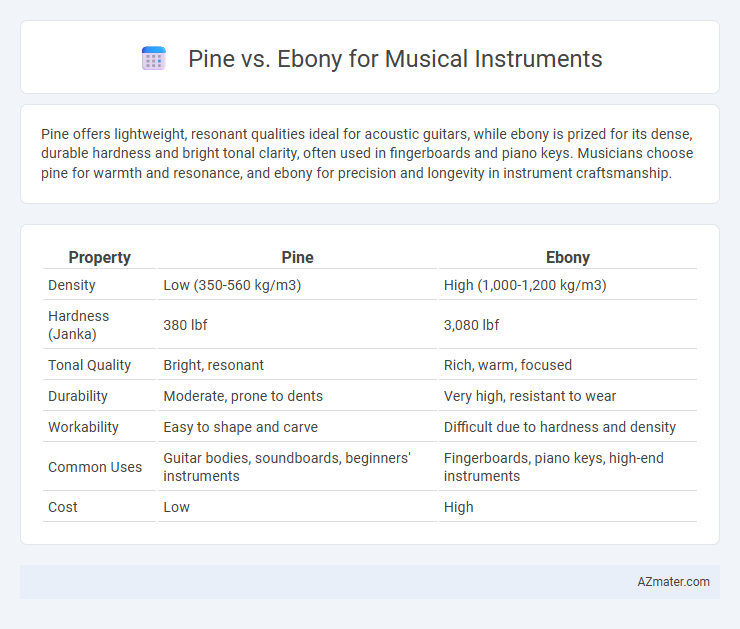Pine offers lightweight, resonant qualities ideal for acoustic guitars, while ebony is prized for its dense, durable hardness and bright tonal clarity, often used in fingerboards and piano keys. Musicians choose pine for warmth and resonance, and ebony for precision and longevity in instrument craftsmanship.
Table of Comparison
| Property | Pine | Ebony |
|---|---|---|
| Density | Low (350-560 kg/m3) | High (1,000-1,200 kg/m3) |
| Hardness (Janka) | 380 lbf | 3,080 lbf |
| Tonal Quality | Bright, resonant | Rich, warm, focused |
| Durability | Moderate, prone to dents | Very high, resistant to wear |
| Workability | Easy to shape and carve | Difficult due to hardness and density |
| Common Uses | Guitar bodies, soundboards, beginners' instruments | Fingerboards, piano keys, high-end instruments |
| Cost | Low | High |
Introduction to Pine and Ebony in Musical Instruments
Pine is a lightweight, softwood commonly used in the construction of acoustic instruments such as guitars and violins, valued for its resonance and affordability. Ebony, a dense hardwood known for its durability and smooth texture, is frequently used in fingerboards, piano keys, and other detailed components requiring hardness and precision. The tonal qualities of pine offer warmth and brightness, while ebony provides a clear, sharp attack and excellent sustain, making each wood suited for specific parts and sonic purposes in musical instruments.
Physical Properties of Pine and Ebony Wood
Pine wood offers a lightweight and soft texture with a lower density typically around 350 kg/m3, contributing to easy workability and resonance in musical instruments, while its porous structure absorbs vibration effectively. Ebony wood exhibits a dense, hard, and fine-grained composition with densities ranging from 1,000 to 1,200 kg/m3, delivering exceptional durability and bright tonal qualities with enhanced sustain. The contrasting physical properties influence the tonal warmth and clarity of instruments, with pine favoring softer, mellow sounds and ebony providing sharper, more articulate notes.
Tonal Characteristics: Pine vs. Ebony
Pine wood offers a bright, warm tonal quality with enhanced resonance and a softer attack, making it suitable for acoustic instruments requiring rich mids and vibrant highs. Ebony provides a dense, hard surface that produces clear, articulate tones with strong sustain and pronounced bass response, favored for fingerboards and parts requiring precision and durability. The choice between pine and ebony significantly affects the instrument's tonal clarity, projection, and overall sound character.
Durability and Longevity in Instrument Making
Ebony is renowned for its exceptional durability and longevity, making it a preferred choice for fretboards and other high-wear components in musical instruments. Pine, while softer and more prone to dents and scratches, offers a lighter weight and resonates well but generally does not withstand long-term wear as effectively as ebony. Instruments constructed with ebony parts tend to maintain structural integrity and tonal stability over decades, whereas pine may require more frequent maintenance and replacement.
Workability and Crafting Differences
Pine offers excellent workability for musical instrument crafting due to its softness and light weight, enabling easier carving, shaping, and faster machining compared to ebony. Ebony is significantly denser and harder, providing superior durability and tonal qualities but requiring specialized tools and greater effort to craft intricate details. The difference in hardness affects sanding and finishing processes, with pine allowing smoother, quicker finishes while ebony demands more time and precision to achieve a polished surface.
Common Instrument Applications for Pine
Pine is widely used for acoustic guitar tops, ukuleles, and banjos due to its light weight and resonant qualities that produce a bright, clear sound ideal for strumming and fingerpicking styles. Compared to ebony, which is primarily utilized for fretboards and fingerboards because of its hardness and durability, pine is favored in body construction where its softness allows for easier shaping and affordability benefits. The tonal characteristics of pine make it suitable for instruments requiring warmth and projection, especially in folk and country music genres.
Common Instrument Applications for Ebony
Ebony is highly favored for fingerboards, piano keys, and woodwind instruments due to its dense, durable, and smooth surface, offering superior wear resistance and a sleek finish that enhances playability. Commonly used in high-end violins, guitars, and clarinets, ebony provides excellent tonal qualities, contributing to clear, bright sound projection. In contrast, pine is rarely chosen for these components because of its softness and lower density, making it more suitable for soundboards and guitar bodies rather than fingerboards or intricate instrument parts.
Cost, Availability, and Sustainability Comparison
Pine is generally more affordable and widely available than ebony, making it a popular choice for budget-conscious musicians and manufacturers. Ebony is a rare, dense hardwood with limited availability due to overharvesting and strict regulations, resulting in higher costs and sustainability concerns. Pine offers a more sustainable option through faster growth and responsible forestry practices, whereas ebony's slow growth and habitat-specific nature raise environmental challenges.
Player Preferences: Sound and Feel
Pine is favored by players seeking a softer, warmer tone with natural resonance, making it ideal for folk and acoustic instruments, while ebony is preferred for its dense, hard qualities that produce bright, clear sound and excellent sustain, commonly used in fingerboards and bridges. The tactile feel of pine offers a lighter, more porous texture enhancing playability during long sessions, whereas ebony provides a smooth, durable surface that supports fast, precise finger movements. Musicians often choose based on genre and playing style, with pine appealing to those valuing organic warmth and ebony attracting players desiring articulate projection and durability.
Choosing Between Pine and Ebony: Key Considerations
Pine offers lightweight properties and a warm tone, making it ideal for acoustic guitars and instruments requiring resonant sound with less weight. Ebony is prized for its dense hardness and smooth feel, providing enhanced durability, bright attack, and superior fretboard stability in electric guitars and higher-end instruments. Choosing between pine and ebony hinges on factors like tonal preference, instrument type, and desired longevity, with pine favoring resonance and ebony excelling in precision and resilience.

Infographic: Pine vs Ebony for Music Instrument
 azmater.com
azmater.com